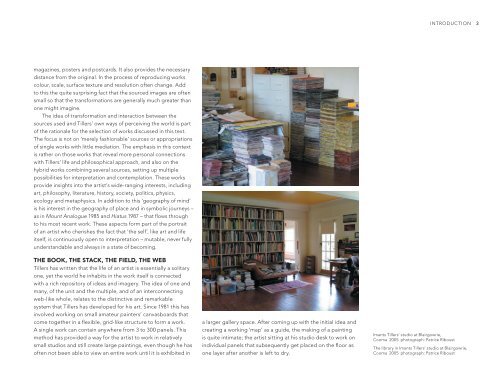introduction: a work in progress - National Gallery of Australia
introduction: a work in progress - National Gallery of Australia
introduction: a work in progress - National Gallery of Australia
Create successful ePaper yourself
Turn your PDF publications into a flip-book with our unique Google optimized e-Paper software.
INTRODUCTION 3<br />
magaz<strong>in</strong>es, posters and postcards. It also provides the necessary<br />
distance from the orig<strong>in</strong>al. In the process <strong>of</strong> reproduc<strong>in</strong>g <strong>work</strong>s<br />
colour, scale, surface texture and resolution <strong>of</strong>ten change. Add<br />
to this the quite surpris<strong>in</strong>g fact that the sourced images are <strong>of</strong>ten<br />
small so that the transformations are generally much greater than<br />
one might imag<strong>in</strong>e.<br />
The idea <strong>of</strong> transformation and <strong>in</strong>teraction between the<br />
sources used and Tillers’ own ways <strong>of</strong> perceiv<strong>in</strong>g the world is part<br />
<strong>of</strong> the rationale for the selection <strong>of</strong> <strong>work</strong>s discussed <strong>in</strong> this text.<br />
The focus is not on ‘merely fashionable’ sources or appropriations<br />
<strong>of</strong> s<strong>in</strong>gle <strong>work</strong>s with little mediation. The emphasis <strong>in</strong> this context<br />
is rather on those <strong>work</strong>s that reveal more personal connections<br />
with Tillers’ life and philosophical approach, and also on the<br />
hybrid <strong>work</strong>s comb<strong>in</strong><strong>in</strong>g several sources, sett<strong>in</strong>g up multiple<br />
possibilities for <strong>in</strong>terpretation and contemplation. These <strong>work</strong>s<br />
provide <strong>in</strong>sights <strong>in</strong>to the artist’s wide-rang<strong>in</strong>g <strong>in</strong>terests, <strong>in</strong>clud<strong>in</strong>g<br />
art, philosophy, literature, history, society, politics, physics,<br />
ecology and metaphysics. In addition to this ‘geography <strong>of</strong> m<strong>in</strong>d’<br />
is his <strong>in</strong>terest <strong>in</strong> the geography <strong>of</strong> place and <strong>in</strong> symbolic journeys –<br />
as <strong>in</strong> Mount Analogue 1985 and Hiatus 1987 – that flows through<br />
to his most recent <strong>work</strong>. These aspects form part <strong>of</strong> the portrait<br />
<strong>of</strong> an artist who cherishes the fact that ‘the self’, like art and life<br />
itself, is cont<strong>in</strong>uously open to <strong>in</strong>terpretation – mutable, never fully<br />
understandable and always <strong>in</strong> a state <strong>of</strong> becom<strong>in</strong>g.<br />
THE BOOK, THE STACK, THE FIELD, THE WEB<br />
Tillers has written that the life <strong>of</strong> an artist is essentially a solitary<br />
one, yet the world he <strong>in</strong>habits <strong>in</strong> the <strong>work</strong> itself is connected<br />
with a rich repository <strong>of</strong> ideas and imagery. The idea <strong>of</strong> one and<br />
many, <strong>of</strong> the unit and the multiple, and <strong>of</strong> an <strong>in</strong>terconnect<strong>in</strong>g<br />
web-like whole, relates to the dist<strong>in</strong>ctive and remarkable<br />
system that Tillers has developed for his art. S<strong>in</strong>ce 1981 this has<br />
<strong>in</strong>volved <strong>work</strong><strong>in</strong>g on small amateur pa<strong>in</strong>ters’ canvasboards that<br />
come together <strong>in</strong> a flexible, grid-like structure to form a <strong>work</strong>.<br />
A s<strong>in</strong>gle <strong>work</strong> can conta<strong>in</strong> anywhere from 3 to 300 panels. This<br />
method has provided a way for the artist to <strong>work</strong> <strong>in</strong> relatively<br />
small studios and still create large pa<strong>in</strong>t<strong>in</strong>gs, even though he has<br />
<strong>of</strong>ten not been able to view an entire <strong>work</strong> until it is exhibited <strong>in</strong><br />
a larger gallery space. After com<strong>in</strong>g up with the <strong>in</strong>itial idea and<br />
creat<strong>in</strong>g a <strong>work</strong><strong>in</strong>g ‘map’ as a guide, the mak<strong>in</strong>g <strong>of</strong> a pa<strong>in</strong>t<strong>in</strong>g<br />
is quite <strong>in</strong>timate; the artist sitt<strong>in</strong>g at his studio desk to <strong>work</strong> on<br />
<strong>in</strong>dividual panels that subsequently get placed on the floor as<br />
one layer after another is left to dry.<br />
Imants Tillers’ studio at Blairgowrie,<br />
Cooma 2005 photograph: Patrice Riboust<br />
The library <strong>in</strong> Imants Tillers’ studio at Blairgowrie,<br />
Cooma 2005 photograph: Patrice Riboust

















